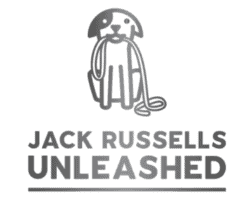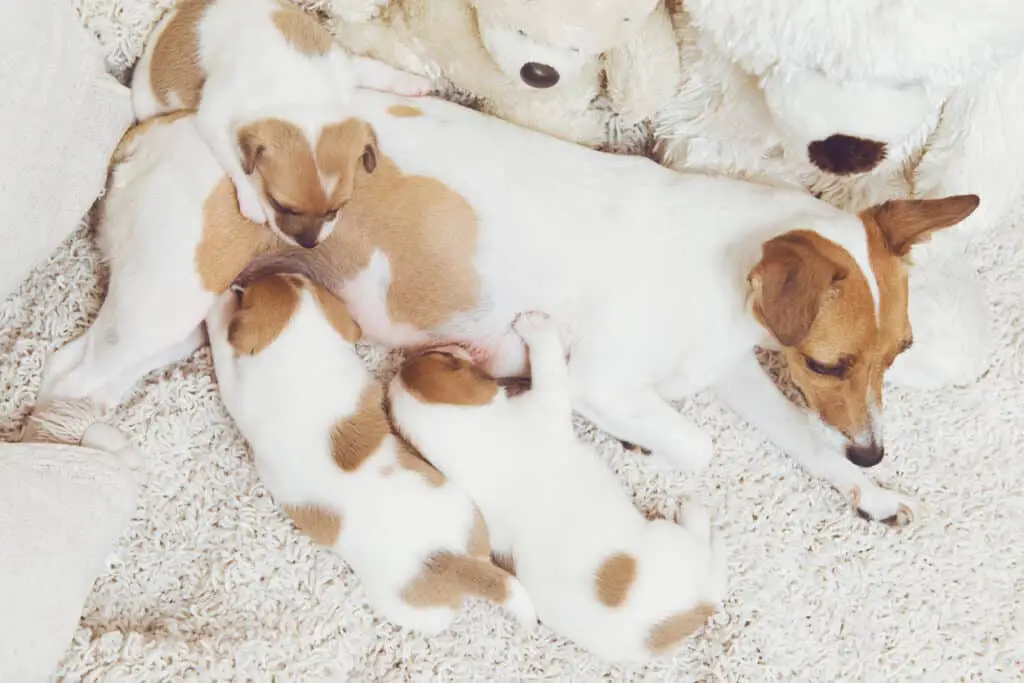Breeding from your female Jack Russell Terrier and helping her raise her pups can be an extremely rewarding experience.
Once your Jack Russell Terrier’s puppies have made their grand entrance into the world, she needs postpartum care. This is extremely important for her health and well-being while she raises her puppies.
Caring for your Jack Russell Terrier mom immediately after delivery
After whelping (giving birth), use warm water and washcloth to gently clean the mother as much as possible without upsetting her. It is important to avoid using any soaps or disinfectants unless your veterinarian has advised you to do so.
Remove any soiled newspaper or bedding from her whelping box after the birth and then ensure this is changed daily after that. This will ensure the whelping box stays clean, hygienic, and safe for her and the puppies.
It is normal for your Jack Russell Terrier to have some greenish-black colored discharge from her vulva after giving birth. This discharge may be quite significant if she has not expelled all the afterbirth, however it should decrease substantially after twenty-four to forty-eight hours. It is important to monitor this and check for any excessive discharge that does not decrease in this time. If you find anything abnormal, call your veterinarian.
Ensure you regularly check your Jack Russell Terrier’s nipples for any swelling, tenderness, or redness. Her milk should be a white color, and not contain any blood or pus. If you find anything abnormal, speak with your veterinarian as soon as possible.
It is quite normal for your Jack Russell Terrier to want to spend most of her time with her puppies and for the first few days it may be difficult to get her to leave the whelping box, even to go to the bathroom. You may need to lead her outside for a short period if she refuses to go on her own. It is important that she continues to urinate and defecate normally.
How will you know if your Jack Russell Terrier mom’s milk supply is adequate?
A content litter of fat puppies is the best indication that the mother is producing adequate milk. If the mother does not produce enough milk or she has developed mastitis (an infection in the mammary glands) the entire litter of puppies will not be properly nourished, cry constantly and fail to gain weight.
If just one or two puppies appear restless or whimpers frequently, they may be being pushed away from the milk by the other puppies. Putting these puppies onto the fullest nipples for feeding may help them get the nourishment they need.
Puppies that fail to gain weight or begin to lose weight for whatever reason may perish within 48 hours. Supplemental feeding with milk replacement products several times a day may be necessary. Your veterinarian can supply the necessary food and feeders (special puppy nursing bottles) and advice on how to do this. For more information on caring for new puppies, click here.
What is the difference between Mastitis and Eclampsia?
Mastitis is an infection of milk ducts that occurs when bacteria enters a crack or scratch in the mother’s nipples. This causes the mammary glands to become increasingly swollen, inflamed, and discolored (frequently red or purple). The most common pathogens that cause mastitis are Escherichia coli, Staphylococcus sp., and Streptococcus sp. Nursing puppies are the most efficient at removing the milk from the glands, however, if the mother is too sore to allow nursing, or if there is a concern of antibiotic treatment transferring to the puppies, supplementary feeding may be needed.
Eclampsia, or milk fever, occurs when blood calcium levels of the mother are depleted due to heavy milk production. It is not an infection. It is also not an indicator or lack of calcium in the mother’s diet, instead the simply means that she cannot mobilize sufficient supplies of stored calcium quickly enough to meet her metabolic needs. Eclampsia occurs most commonly when the mother is producing the most milk, usually around the three-to-five-week mark. Signs of eclampsia include tremors, weakness, and a form of paralysis where the mother dog has stiff limbs and an inability to stand or walk called “puerperal tetany”. Eclampsia is an emergency and if you suspect eclampsia is developing, prevent the puppies from suckling and contact your veterinarian immediately.
When and how to increase your Jack Russell Terrier mom’s food?
During the last few weeks of pregnancy you should have increased your Jack Russell Terrier’s food intake to help her with the increasing nutritional demands of growing her puppies. However, don’t be alarmed she does not eat very much for twenty-four to forty-eight hours after whelping. This is normal and she should regain her appetite after a couple of days.
Once she regains her appetite, her food requirements increase further because she is producing milk for her puppies. It is important to increase the frequency of feeding rather than the volume per meal and avoid any sudden changes in the type of food you feed her.
Peak milk production occurs approximately three to five weeks after whelping and at this time it is not unusual for her to be eating three to four times her normal maintenance diet. This amount of course will vary according to the size of her litter and her physical condition. It is important to ensure your Jack Russell Terrier consumes plenty of water particularly if she is on a dry diet. It is not necessary to feed her milk or any milk substitutes while she is lactating.
The ideal diet for a lactating mother Jack Russell Terrier should contain optimal levels of the omega-3 fatty acid, DHA (docosahexaenoic acid), the nutrient responsible for the development of the puppies’ brains and eyes. Feeding your Jack Russell Terrier a specially formulated commercial dry food for lactating mothers will provide her with a decent calorific amount of healthy fats and proteins to meet the nutritional needs of growing puppies.
It is important to note that your dog’s instincts tell her that eating the placenta is part of her job after her puppies are born. Eating the afterbirth helps to stimulate milk production and provides her with the minerals and nutrients she needs and assists her body to recover quickly so she can take care of her puppies. It is important to be aware that eating the placenta can also cause diarrhea.
As your puppies begin the weaning process, the mother dog’s milk production will decrease. Around the week four mark is the time to begin slowly transitioning the mother dog back to her maintenance diet. Then by week seven or eight when her puppies are completely weaned, her milk production will cease.
What shall I do if the mother refuses to stay with the puppies?
Newborn puppies cannot maintain their own body temperature for a week or two after whelping but so long as the puppies stay close to their mother and each other they will get the warmth they need. Sometimes pets that are closely attached to their owners choose not to stay with their puppies.
If the mother will not stay with her puppies, it might be worth relocating the whelping box and puppies nearer to you or installing an external source of warmth in the whelping box. You can use a puppy safe heat pad that is designed to provide warmth without getting too hot. To avoid overheating there should also be a cooler corner of the whelping box that the pups can crawl to if needed.
Is it necessary to keep my Jack Russell Terrier and her puppies in subdued light?
It depends. Instinctually some Jack Russell Terrier females will become anxious and start carrying their puppies around the house looking for a secluded spot to hide them like they would in the wild.
If the mother does not like the place you have selected for the whelping box, try placing a blanket over part of the box or providing an enclosed crate to give her feelings of safety.
Stress can affect her milk supply and may cause problems with the puppies so if this does not work and she is still unsettled, contact your veterinarian for advice.
Why do some Jack Russell Terriers kill and eat their puppies?
In the wild, it is a mother’s instinct to protect her puppies as any predatory attack could be fatal. Sometimes when puppies become vocal and distressed, the mother’s primeval protective instinct surfaces and she will try to lessen the danger from a predator. This could include killing and eating one or more of her puppies as a way of avoiding this perceived danger.
Other times mothers will kill a puppy that fails to thrive, has a birth defect, or appears sickly. This is considered normal behavior and is not cause for concern or indicative of bad “parenting”.
Caring for you Jack Russell Terrier while weaning her puppies
The weaning process begins around three weeks of age. It is a gradual process where the puppies feed less and less from their mother and her milk supply starts to dry up.
It is important to monitor the mother during this process to ensure that there is no discharge from her vulva and that her mammary glands (except for her prominent nipples) are going back to their normal size. It is also important to regularly check the mammary glands for any abnormal discharge, inflammation, tenderness, or hardness. By the conclusion of weaning there should be no obvious signs that she has raised a litter of puppies.
Once the puppies are removed, sometimes several mammary glands still hang down, indicating that the mother did not dry up well. One way of correcting this is to reduce her food intake slightly below maintenance level for a few days before removing the puppies. For a mother with a lot of milk, it may be wise to completely remove her food for 24 hours prior to removing the puppies to help her milk supply dry up. Mastitis can occur quickly if the puppies are removed and she still has a good supply of milk.
Sources:
Breeding For Dog Owners Caring From Birth To Weaning | VCA Animal Hospitals (vcahospitals.com)
Weaning Puppies: How to Wean Puppies and When to Start | PetMD
Breeding For Dog Owners Caring For Newborn Puppies | VCA Animal Hospitals (vcahospitals.com)




![How Much Exercise Does A Jack Russell Terrier Need? [Complete guide for all life stages]](https://jackrussellsunleashed.com/wp-content/uploads/2022/03/iStock-1143749718-1024x683.jpg)
![My Jack Russell Terrier Hates Baths! [4 reasons why & 5 helpful bath time tips]](https://jackrussellsunleashed.com/wp-content/uploads/2022/03/iStock-613556174-1024x683.jpg)
